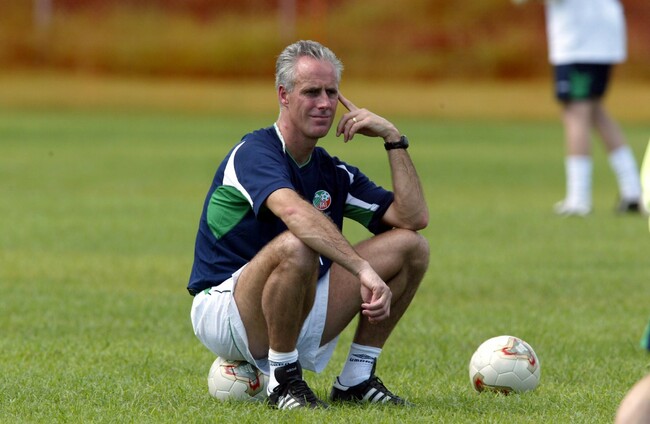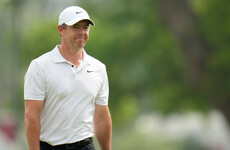IRELAND’S LOVE-HATE relationship with Mick McCarthy is perhaps best epitomised by RTÉ pundit Eamon Dunphy’s evolving attitude to the Barnsley-born coach.
During McCarthy’s time as Ireland manager, Dunphy was often heavily critical of Jack Charlton’s successor, once memorably commenting: “He’s one of the biggest whingers in world football… He’s a bloody eejit.”
The Irish public were also harsh on McCarthy at times. Despite guiding Ireland to the last-16 of the World Cup — a feat no Irish manager has come close to emulating since — there was widespread dissatisfaction shortly thereafter. Just two competitive games later, McCarthy departed, following losses to Russia and Switzerland in the opening Euro 2004 qualifiers.
Towards the end of the Swiss game at Lansdowne Road, chants of ‘Keano’ rang around the stadium and the then-Irish manager was booed by a section of the home support. Many people, it seemed, had not quite forgiven McCarthy for his role in the Saipan debacle, and Keane’s insistence that he would never again play for Ireland again so long as his nemesis was in charge didn’t help matters.
People were happy to support McCarthy’s side so long as they were winning, but as soon as the results went awry, people started to take a less sympathetic view. Dunphy also traced McCarthy’s downfall to those crazy few days in Saipan the previous summer.
“The buck always stops with the manager in football, unfortunately,” the RTÉ analyst said, following news of McCarthy’s resignation. “(Saipan) was harrowing for all people involved. It has been a very, very unhappy experience and it should never have got to this stage. Mick McCarthy was the person in charge of that situation and he should have managed it better.”
Yet like the Irish public at large, Dunphy’s views towards McCarthy have softened in recent years. After seeing Trapattoni’s Ireland side get hammered 6-1 by Germany in October 2012, the controversial critic said: “I saw Mick McCarthy in the corridor tonight, I wouldn’t mind Mick McCarthy coming back. He’s proven himself since he left the Irish job and he took us to the World Cup… I wasn’t his greatest fan, I’ll hold my hands up now and say that he’s subsequently proved himself to be a much better manager than many people thought, including me.”
In the end, in 2013, McCarthy was overlooked for the Ireland job in favour of Martin O’Neill, which was possibly for the best, given that the Derry native qualified Ireland for the Euros while the former centre-half continued to work minor miracles with cash-strapped Ipswich in the Championship.
Moreover, McCarthy’s legacy with Ireland, which seems to get better with each passing year and every World Cup the team fails to qualify for, remains unblemished.
But what is his legacy? Understandably, most people consider Jack Charlton to be Ireland’s greatest-ever manager and there is plenty of evidence to support that assertion — Ireland qualified for more tournaments under the Northumberland native than anyone else, while his win ratio (50.5%) is bettered only by Brian Kerr (54.5%). One important factor to consider, though, is the squad Charlton inherited versus the one McCarthy was dealt.
Consider the team for Ireland’s first match under Charlton (a 0–1 friendly loss to Wales at Lansdowne Road): Gerry Peyton, Dave Langan, David O’Leary, Paul McGrath, Jim Beglin, Liam Brady, Ray Houghton, Ronnie Whelan, John Aldridge, Michael Robinson, John Anderson.
So Charlton took over an excellent side, with several players coming into their peak, not to mention other top-class footballers who were available during that era, such as Packie Bonner, Kevin Sheedy and Frank Stapleton. While Ray Houghton, John Aldridge, Andy Townsend and Paul McGrath among others were still playing when McCarthy was appointed, all were well past their best and coming towards the end of their careers.
In 1996, the Boys in Green’s one genuinely world-class player at the time, Roy Keane, had been handed the captaincy by a newly appointed McCarthy. However, in a Shakespearean premonition of what was to come, the Man United man handled this new responsibility poorly initially, getting sent off for a petulant kick during the Irish manager’s first match in charge — a 2-0 friendly loss to Russia at Lansdowne Road.
It was therefore always going to be a gradual rebuilding process under McCarthy, but the Barnsley native did a good job all things considered. Granted, his first two qualification campaigns were unsuccessful, but Ireland certainly didn’t get much luck during these years.
The bid to reach the 1998 World Cup was ended at the playoff stage by a talented Begium side containing top players like Luís Oliveira and Luc Nilis. The Irish team, meanwhile, was a mixture of inexperienced youngsters (David Connolly, Shay Given, Ian Harte) and the last remnants of the Charlton generation (Ray Houghton, Andy Townsend, Tony Cascarino).
It was only in the Euro 2000 qualifiers that the team began to truly feel like Mick McCarthy’s side, as the last ghosts of the Charlton era were exorcised. Ireland were paired in a daunting group with World Cup semi-finalists Croatia and Yugoslavia (who had reached the last 16 of the previous summer’s tournament in France). The Boys in Green performed above expectations, and were literally seconds away from qualifying as group winners, before a late Macedonia equaliser broke Irish hearts to prevent automatic qualification. This bad luck continued in the playoffs against Turkey, as Ireland were without suspended star striker Robbie Keane for the second leg, and the 0-0 outcome meant McCarthy’s men lost out on away goals.
Ireland seemed doomed to failure again for the 2002 World Cup qualifiers, as they were paired with Holland and Portugal (both of whom were semi-finalists at the European Championships in 2000). Therefore, coming through this unenviable group, winning a playoff in the hostile atmosphere of Iran in the playoffs and putting in an extremely creditable display at the World Cup, despite the loss of the team’s inspirational skipper, was surely up there with any of Charlton’s achievements.
And perhaps more significantly, as alluded to earlier, Charlton had superior players to work with. Granted, McCarthy got some of Roy Keane’s best years, but apart from the Man United star, who was there?
Robbie Keane, Damien Duff, Richard Dunne and Shay Given were only starting to fulfil their potential towards the end of McCarthy’s reign. And to be frank, those players aside, McCarthy was working with an average Premier League side at best, whereas Charlton could rely on countless players who had won silverware at club level to choose from.
Gary Breen, for instance, was a free agent when he was performing with distinction at the heart of Ireland’s defence at the 2002 World Cup. Charlton, by contrast, was so blessed with defensive options that he often had the luxury of playing Paul McGrath — a technically proficient footballer as well as a no-nonsense centre-half — in midfield.
McCarthy also significantly developed Ireland’s style of football. While he was not averse to using a Niall Quinn or a Tony Cascarino-type figure as a target man when necessary, he also ensured Ireland were a team capable of playing attractive, attacking, passing football, even against some of the best sides in the world. In the 2002 World Cup, Ireland had 58% possession in comparison to Germany’s 42% over the duration of the 90 minutes. Against Spain in the last-16, they had 55% of the ball. Ireland have not played better football arguably before or since.
Charlton’s ‘put ‘em under pressure’ style, while hugely effective initially, was growing increasingly redundant owing to the introduction of the back-pass rule and by his departure in 1995, the former Leeds player’s approach was looking as tired and dated as some of his players. McCarthy knew a strategic shake-up was needed and thus, he began to implement a more expansive footballing philosophy, where playing the ball out from the back was invariably encouraged rather than frowned upon.
Whereas it’s difficult to imagine ball players like Keane and Duff being accommodated in Charlton’s system, they were allowed to thrive with McCarthy at the helm. So when you remember McCarthy in years to come, think about all these positives as his legacy, rather than one deeply unfortunate footnote in an otherwise incredibly successful 2002 World Cup campaign.












Yes any county want and need best hurlers on the pitch ! But must also behave of it ! How many of the pitch incidents have Barrett notched up ?